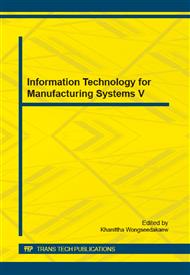[1]
T. Aksoy, MSc Thesis, Investigation of cutting tool performance and chip geometry in machining PMD 23 steel produced by powder metallurgy, Institute of Science, Investigation of cutting tool performance and chip geometry in machining PMD 23 steel produced by powder metallurgy, Kırıkkale University, 2009, p.130.
DOI: 10.1179/003258904225020774
Google Scholar
[2]
I. Asilturk, H. Akkus, Determining the effect of cutting parameters on surface roughness in hard turning using the Taguchi method, Measurement, 44 (2011), pp.1697-1704.
DOI: 10.1016/j.measurement.2011.07.003
Google Scholar
[3]
J.P. Davim, L. Figueira, Machinability evaluation in hard turning of cold work tool steel (D2) with ceramic tools using statistical techniques, Materials & Design, 28 (2007), pp.1186-1191.
DOI: 10.1016/j.matdes.2006.01.011
Google Scholar
[4]
Z. Hessainia, A. Belbah, M.A. Yallese, T. Mabrouki, J.F. Rigal: On the prediction of surface roughness in the hard turning based on cutting parameters and tool vibrations, Measurement, 46 (2013), pp.1671-1681.
DOI: 10.1016/j.measurement.2012.12.016
Google Scholar
[5]
A. Kacal, M. Gulesin, Determination of optimal cutting conditions in finish turning of austempered ductile iron using Taguchi design method, Journal of Scientific & Industrial Research, 70 (2011), pp.278-283.
Google Scholar
[6]
A. Kacal, F. Yildirim, "Application of grey relational analysis in high-speed machining of hardened AISI D6 steel, Proceedings of the Institution of Mechanical Engineers Part C-Journal of Mechanical Engineering Science, 227 (2013), pp.1566-1576.
DOI: 10.1177/0954406212466792
Google Scholar
[7]
D.I. Lalwani, N.K. Mehta, P.K. Jain, Experimental investigations of cutting parameters influence on cutting forces and surface roughness in finish hard turning of MDN250 steel, Journal of Materials Processing Technology, 206 (2008), pp.167-179.
DOI: 10.1016/j.jmatprotec.2007.12.018
Google Scholar
[8]
D. Singh, P.V. Rao, A surface roughness prediction model for hard turning process, International Journal of Advanced Manufacturing Technology, 32 (2007), pp.1115-1124.
DOI: 10.1007/s00170-006-0429-2
Google Scholar
[9]
R.G. Sood, C Malkin, S, Turning of Hardened Steels, Journal of Manufacturing Processes, 2 (2000), pp.187-193.
DOI: 10.1016/s1526-6125(00)70120-4
Google Scholar
[10]
R. Suresh, S. Basavarajappa, V.N. Gaitonde, G.L. Samuel, Machinability investigations on hardened AISI 4340 steel using coated carbide insert, International Journal of Refractory Metals & Hard Materials, 33 (2012), pp.75-86.
DOI: 10.1016/j.ijrmhm.2012.02.019
Google Scholar
[11]
M.W. Azizi, S. Belhadi, M.A. Yallese, T. Mabrouki, J.F. Rigal, Surface roughness and cutting forces modeling for optimization of machining condition in finish hard turning of AISI 52100 steel, Journal of Mechanical Science and Technology, 26 (2012).
DOI: 10.1007/s12206-012-0885-6
Google Scholar
[12]
E. Bingul, A. Kacal, Hard Turning of Powder Metallurgical Cold Work Tool Steel Tempered in Different Tempering Temperature, Journal Of Scientific & Industrial Research, 72 (2013), pp.498-505.
Google Scholar
[13]
V.N. Gaitonde, S.R. Karnik, L. Figueira, J.P. Davim, Performance comparison of conventional and wiper ceramic inserts in hard turning through artificial neural network modeling, International Journal of Advanced Manufacturing Technology, 52 (2011).
DOI: 10.1007/s00170-010-2714-3
Google Scholar
[14]
M.P. Grover, Fundementals of modern manufacturing, Wiley, New York, (1999).
Google Scholar
[15]
S. Kalpakjian, S. R. Schimid, Manufacturing engineering and technology fourth edition, Prentice Hall, New Jersey, (2001).
Google Scholar
[16]
A. Salak, M. Selacka, H. Danninger, Machinability of powder metallurgy steels, Cambridge, (2004).
Google Scholar
[17]
M.S. Dogra, V. S. Durejac, J., Effect of tool geometry variation on finish turning – A Review, Journal of Engineering Science and Technology Review, 4 (2011), pp.1-13.
Google Scholar
[18]
W. Grzesik, Influence of tool wear on surface roughness in hard turning using differently shaped ceramic tools, Wear, 265 (2008), pp.327-335.
DOI: 10.1016/j.wear.2007.11.001
Google Scholar
[19]
G. Bartarya, S.K. Choudhury, Effect of cutting parameters on cutting force and surface roughness during finish hard turning AISI 52100 grade steel, in: K. Wegener (Ed. ) Fifth Cirp Conference on High Performance Cutting 2012, Elsevier Science Bv, Amsterdam, 2012, pp.651-656.
DOI: 10.1016/j.procir.2012.05.016
Google Scholar
[20]
Y.R. Liu, J.J. Liu, Z. Du, The cutting performance and wear mechanism of ceramic cutting tools with MoS2 coating deposited by magnetron sputtering, Wear, 231 (1999), pp.285-292.
DOI: 10.1016/s0043-1648(99)00168-4
Google Scholar
[21]
A.P. Paiva, P.H. Campos, J.R. Ferreira, L.G.D. Lopes, E.J. Paiva, P.P. Balestrassi, A multivariate robust parameter design approach for optimization of AISI 52100 hardened steel turning with wiper mixed ceramic tool, International Journal of Refractory Metals & Hard Materials, 30 (2012).
DOI: 10.1016/j.ijrmhm.2011.08.001
Google Scholar
[22]
G. Poulachon, B.P. Bandyopadhyay, I.S. Jawahir, S. Pheulpin, E. Seguin, "Wear behavior of CBN tools while turning various hardened steels, Wear, 256 (2004), pp.302-310.
DOI: 10.1016/s0043-1648(03)00414-9
Google Scholar
[23]
D. Jin, Z.Q. Liu, Effect of cutting speed on surface integrity and chip morphology in high-speed machining of PM nickel-based superalloy FGH95, International Journal of Advanced Manufacturing Technology, 60 (2012), pp.893-899.
DOI: 10.1007/s00170-011-3679-6
Google Scholar
[24]
D. Jin, Z.Q. Liu, W. Yi, G.S. Su, Influence of cutting speed on surface integrity for powder metallurgy nickel-based superalloy FGH95, International Journal of Advanced Manufacturing Technology, 56 (2011) , pp.553-559.
DOI: 10.1007/s00170-011-3196-7
Google Scholar
[25]
V.N. Gaitonde, S.R. Karnik, L. Figueira, J.P. Davim, Machinability investigations in hard turning of AISI D2 cold work tool steel with conventional and wiper ceramic inserts, International Journal of Refractory Metals & Hard Materials, 27 (2009).
DOI: 10.1016/j.ijrmhm.2008.12.007
Google Scholar
[26]
F. Mahfoudi, G. List, A. Molinari, A. Moufki, L. Boulanouar, High speed turning for hard material with PCBN inserts: tool wear analysis, İnternational Journal of Machining and Machinability of Materials, 3 (2008), pp.62-79.
DOI: 10.1504/ijmmm.2008.017625
Google Scholar
[27]
V.N. Gaitonde, S.R. Karnık, L. Figuera, J.P. Davim, Analysis of machinability during hard turning of cold work tool steel (Type: AISI D2), Materials and Manufacturing Processes, 24 (2009), pp.1373-1382.
DOI: 10.1080/10426910902997415
Google Scholar
[28]
A.S. More, W. P. Jiang, W. D. Brown., A.P. Malshe, Tool wear and machining performance of CBN-TiN coated carbide inserts and PCBN compact inserts in turning AISI 4340 hardened steel, Journal of Materials Processing Technology, 180 (2006).
DOI: 10.1016/j.jmatprotec.2006.06.013
Google Scholar
[29]
D.G. Thakur, B. Ramamoorthy, L. Vijayaraghavan, Machinability Investigation of Inconel 718 in High Speed Turning, İnternational Journal of Advanced Manufacturing Technology, 45 (2009), pp.421-429.
DOI: 10.1007/s00170-009-1987-x
Google Scholar


